Business Research Proposal: International Students in Australia
VerifiedAdded on 2021/06/14
|14
|3048
|310
Report
AI Summary
This business research proposal investigates the multifaceted impact of international students on the Australian economy. It begins with an introduction highlighting the economic significance of international education in Australia and the need to understand the challenges faced by international students. The proposal outlines project objectives, including a literature review, the development of research questions, and the identification of knowledge gaps in existing research. The project scope encompasses plans for identifying issues affecting international students, data collection strategies, sample group determination, and an analysis of the economic impact. The literature review explores the benefits and disadvantages of international students, focusing on increased export income, contributions to GDP, employment opportunities, and social contributions through cultural diversity. It also addresses potential negative impacts such as infrastructure strain and perceived reductions in education quality. Research questions are formulated to explore how the Australian economy responds to help international students mitigate challenges, particularly cultural differences and their impact on social interactions and academic performance. The research design and methodology involve conducting personal interviews with international students to understand their experiences and the utilization of learning styles. The proposal acknowledges limitations related to the interpretation of findings and scope. The research is proposed to be completed within three months.
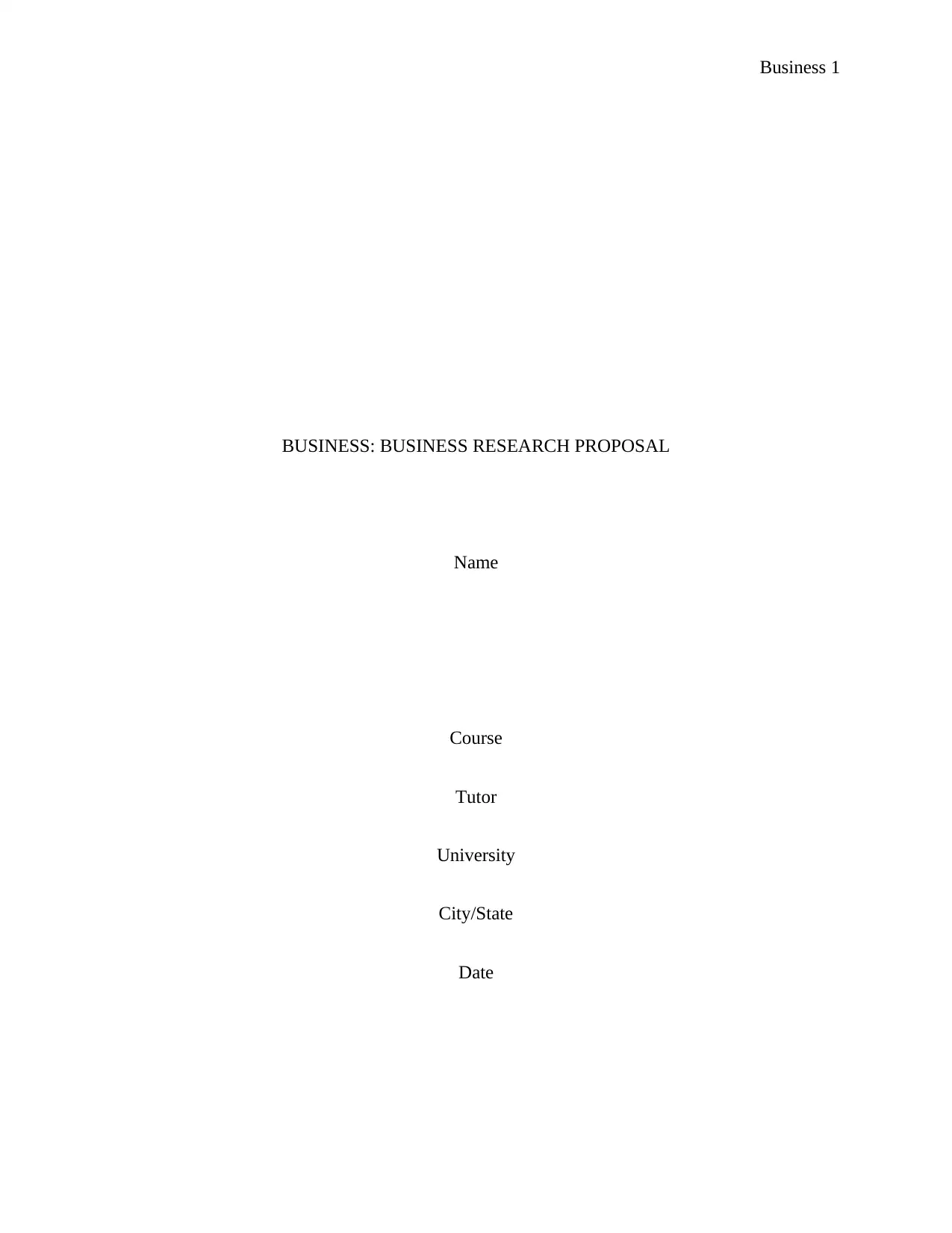
Business 1
BUSINESS: BUSINESS RESEARCH PROPOSAL
Name
Course
Tutor
University
City/State
Date
BUSINESS: BUSINESS RESEARCH PROPOSAL
Name
Course
Tutor
University
City/State
Date
Paraphrase This Document
Need a fresh take? Get an instant paraphrase of this document with our AI Paraphraser
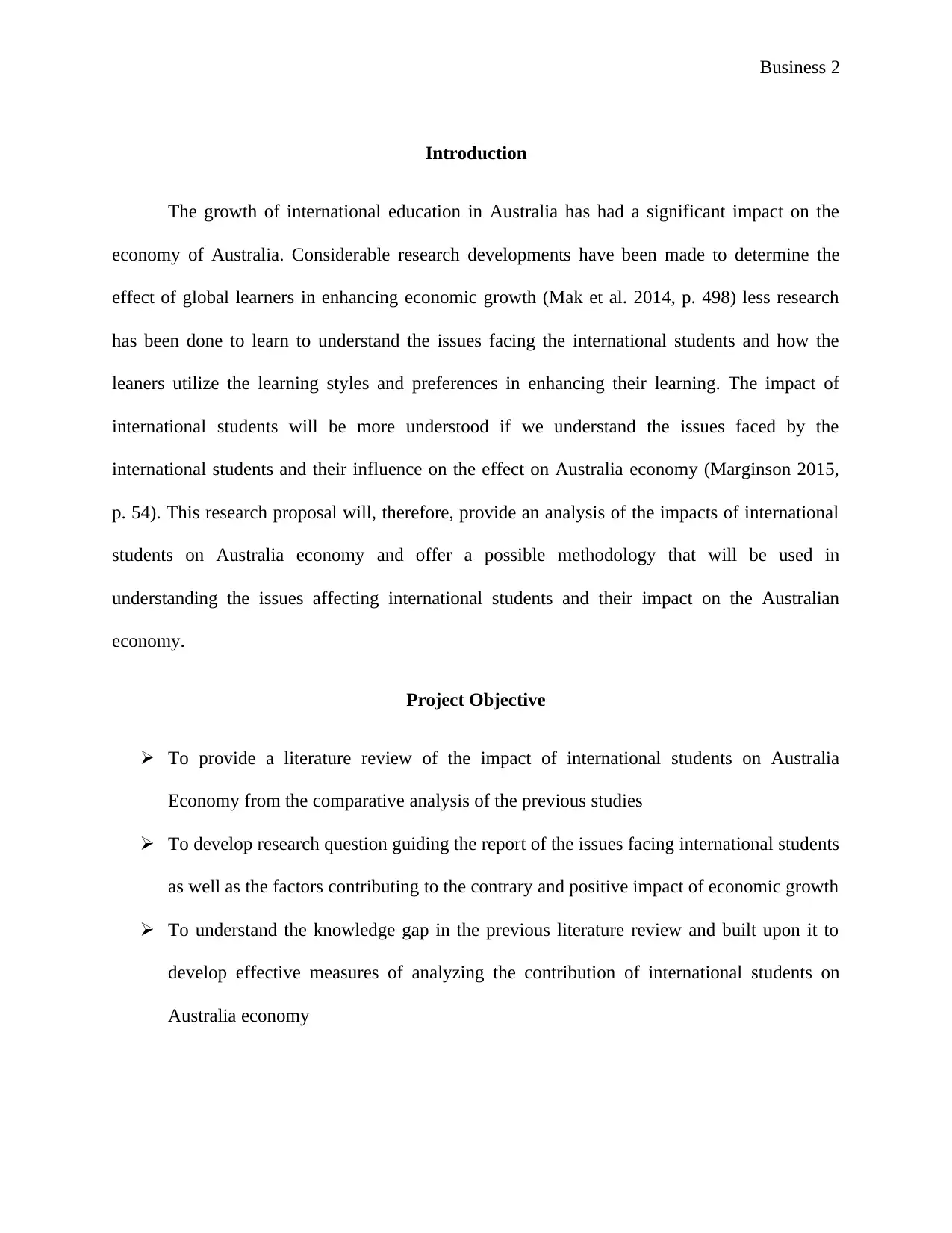
Business 2
Introduction
The growth of international education in Australia has had a significant impact on the
economy of Australia. Considerable research developments have been made to determine the
effect of global learners in enhancing economic growth (Mak et al. 2014, p. 498) less research
has been done to learn to understand the issues facing the international students and how the
leaners utilize the learning styles and preferences in enhancing their learning. The impact of
international students will be more understood if we understand the issues faced by the
international students and their influence on the effect on Australia economy (Marginson 2015,
p. 54). This research proposal will, therefore, provide an analysis of the impacts of international
students on Australia economy and offer a possible methodology that will be used in
understanding the issues affecting international students and their impact on the Australian
economy.
Project Objective
To provide a literature review of the impact of international students on Australia
Economy from the comparative analysis of the previous studies
To develop research question guiding the report of the issues facing international students
as well as the factors contributing to the contrary and positive impact of economic growth
To understand the knowledge gap in the previous literature review and built upon it to
develop effective measures of analyzing the contribution of international students on
Australia economy
Introduction
The growth of international education in Australia has had a significant impact on the
economy of Australia. Considerable research developments have been made to determine the
effect of global learners in enhancing economic growth (Mak et al. 2014, p. 498) less research
has been done to learn to understand the issues facing the international students and how the
leaners utilize the learning styles and preferences in enhancing their learning. The impact of
international students will be more understood if we understand the issues faced by the
international students and their influence on the effect on Australia economy (Marginson 2015,
p. 54). This research proposal will, therefore, provide an analysis of the impacts of international
students on Australia economy and offer a possible methodology that will be used in
understanding the issues affecting international students and their impact on the Australian
economy.
Project Objective
To provide a literature review of the impact of international students on Australia
Economy from the comparative analysis of the previous studies
To develop research question guiding the report of the issues facing international students
as well as the factors contributing to the contrary and positive impact of economic growth
To understand the knowledge gap in the previous literature review and built upon it to
develop effective measures of analyzing the contribution of international students on
Australia economy
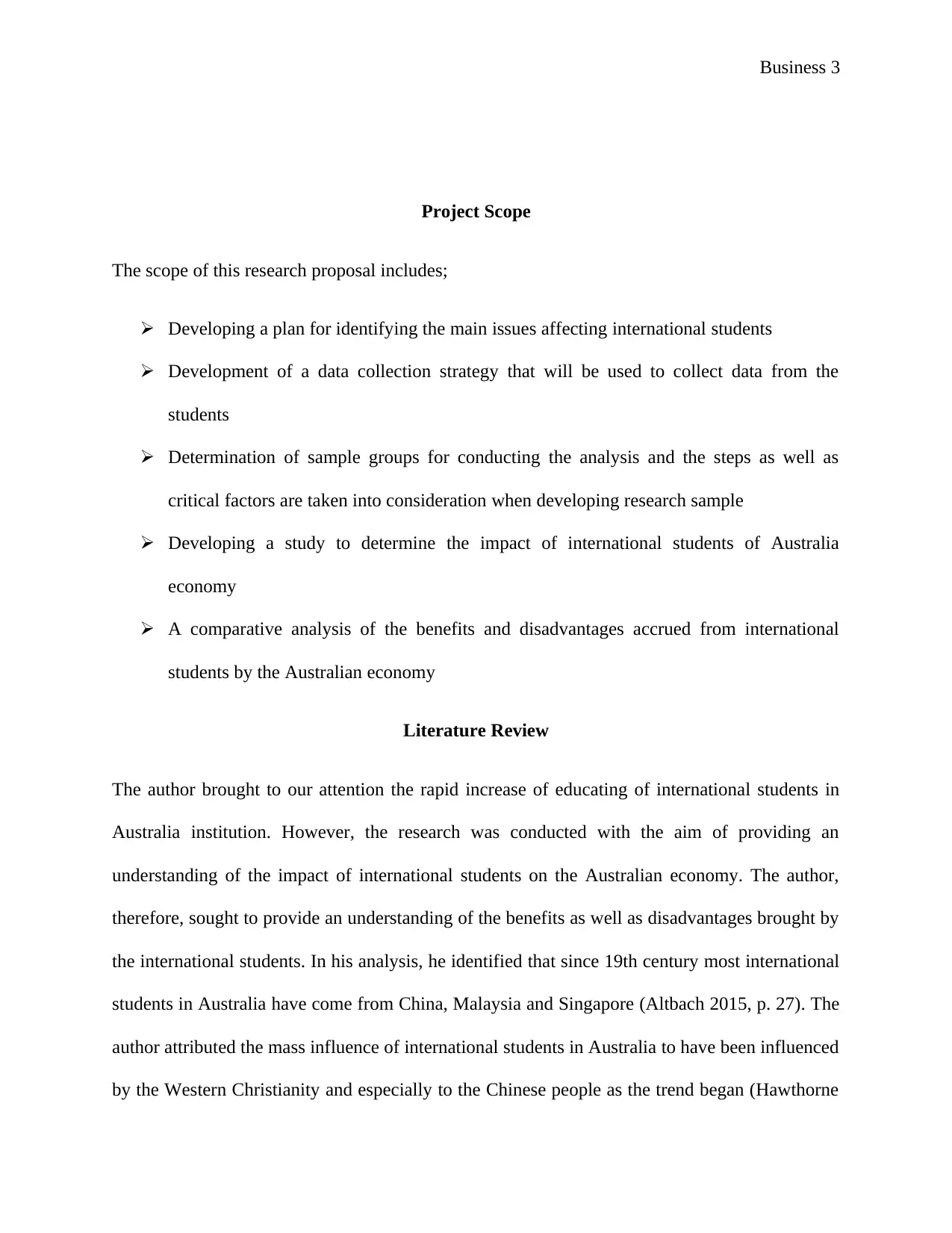
Business 3
Project Scope
The scope of this research proposal includes;
Developing a plan for identifying the main issues affecting international students
Development of a data collection strategy that will be used to collect data from the
students
Determination of sample groups for conducting the analysis and the steps as well as
critical factors are taken into consideration when developing research sample
Developing a study to determine the impact of international students of Australia
economy
A comparative analysis of the benefits and disadvantages accrued from international
students by the Australian economy
Literature Review
The author brought to our attention the rapid increase of educating of international students in
Australia institution. However, the research was conducted with the aim of providing an
understanding of the impact of international students on the Australian economy. The author,
therefore, sought to provide an understanding of the benefits as well as disadvantages brought by
the international students. In his analysis, he identified that since 19th century most international
students in Australia have come from China, Malaysia and Singapore (Altbach 2015, p. 27). The
author attributed the mass influence of international students in Australia to have been influenced
by the Western Christianity and especially to the Chinese people as the trend began (Hawthorne
Project Scope
The scope of this research proposal includes;
Developing a plan for identifying the main issues affecting international students
Development of a data collection strategy that will be used to collect data from the
students
Determination of sample groups for conducting the analysis and the steps as well as
critical factors are taken into consideration when developing research sample
Developing a study to determine the impact of international students of Australia
economy
A comparative analysis of the benefits and disadvantages accrued from international
students by the Australian economy
Literature Review
The author brought to our attention the rapid increase of educating of international students in
Australia institution. However, the research was conducted with the aim of providing an
understanding of the impact of international students on the Australian economy. The author,
therefore, sought to provide an understanding of the benefits as well as disadvantages brought by
the international students. In his analysis, he identified that since 19th century most international
students in Australia have come from China, Malaysia and Singapore (Altbach 2015, p. 27). The
author attributed the mass influence of international students in Australia to have been influenced
by the Western Christianity and especially to the Chinese people as the trend began (Hawthorne
⊘ This is a preview!⊘
Do you want full access?
Subscribe today to unlock all pages.

Trusted by 1+ million students worldwide
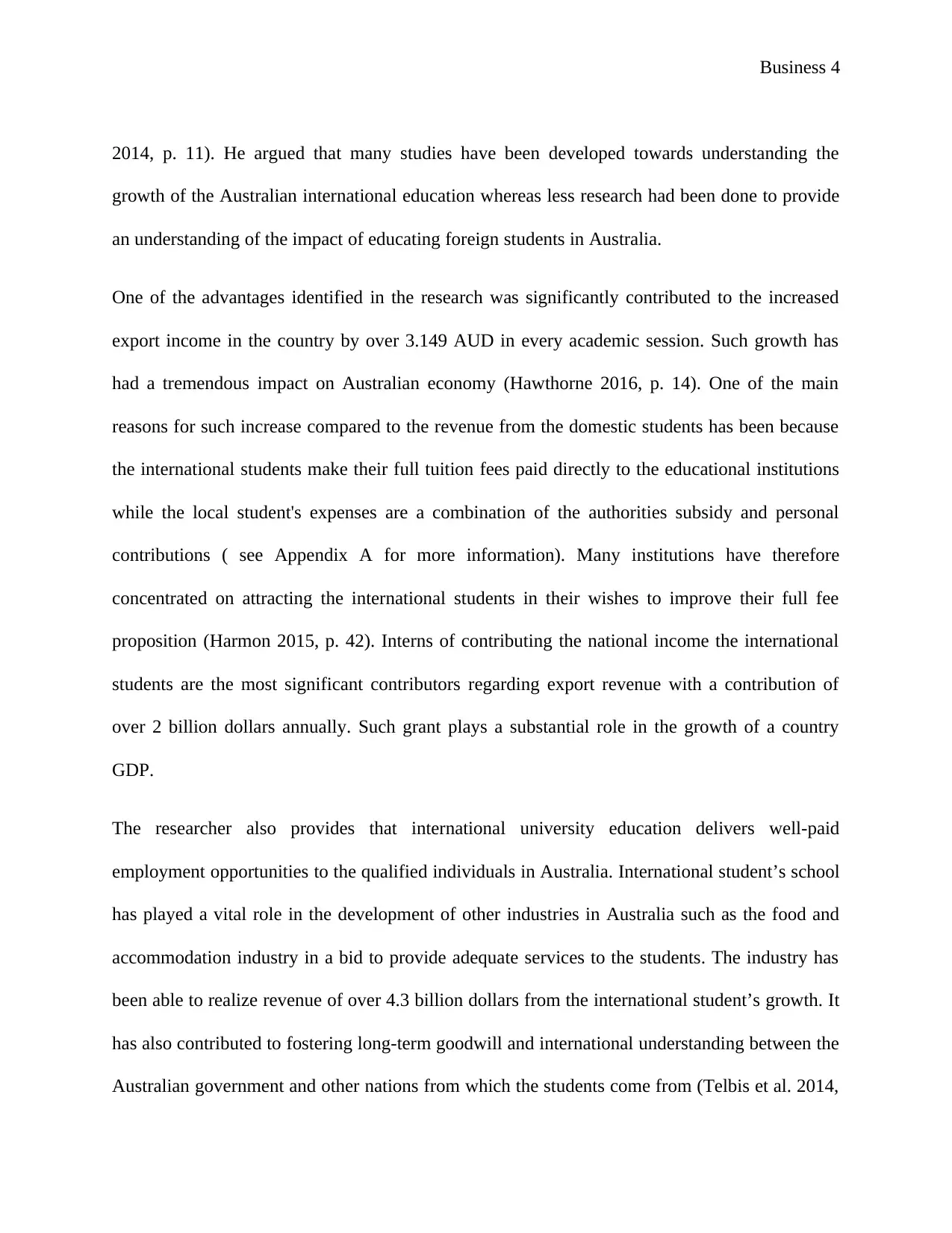
Business 4
2014, p. 11). He argued that many studies have been developed towards understanding the
growth of the Australian international education whereas less research had been done to provide
an understanding of the impact of educating foreign students in Australia.
One of the advantages identified in the research was significantly contributed to the increased
export income in the country by over 3.149 AUD in every academic session. Such growth has
had a tremendous impact on Australian economy (Hawthorne 2016, p. 14). One of the main
reasons for such increase compared to the revenue from the domestic students has been because
the international students make their full tuition fees paid directly to the educational institutions
while the local student's expenses are a combination of the authorities subsidy and personal
contributions ( see Appendix A for more information). Many institutions have therefore
concentrated on attracting the international students in their wishes to improve their full fee
proposition (Harmon 2015, p. 42). Interns of contributing the national income the international
students are the most significant contributors regarding export revenue with a contribution of
over 2 billion dollars annually. Such grant plays a substantial role in the growth of a country
GDP.
The researcher also provides that international university education delivers well-paid
employment opportunities to the qualified individuals in Australia. International student’s school
has played a vital role in the development of other industries in Australia such as the food and
accommodation industry in a bid to provide adequate services to the students. The industry has
been able to realize revenue of over 4.3 billion dollars from the international student’s growth. It
has also contributed to fostering long-term goodwill and international understanding between the
Australian government and other nations from which the students come from (Telbis et al. 2014,
2014, p. 11). He argued that many studies have been developed towards understanding the
growth of the Australian international education whereas less research had been done to provide
an understanding of the impact of educating foreign students in Australia.
One of the advantages identified in the research was significantly contributed to the increased
export income in the country by over 3.149 AUD in every academic session. Such growth has
had a tremendous impact on Australian economy (Hawthorne 2016, p. 14). One of the main
reasons for such increase compared to the revenue from the domestic students has been because
the international students make their full tuition fees paid directly to the educational institutions
while the local student's expenses are a combination of the authorities subsidy and personal
contributions ( see Appendix A for more information). Many institutions have therefore
concentrated on attracting the international students in their wishes to improve their full fee
proposition (Harmon 2015, p. 42). Interns of contributing the national income the international
students are the most significant contributors regarding export revenue with a contribution of
over 2 billion dollars annually. Such grant plays a substantial role in the growth of a country
GDP.
The researcher also provides that international university education delivers well-paid
employment opportunities to the qualified individuals in Australia. International student’s school
has played a vital role in the development of other industries in Australia such as the food and
accommodation industry in a bid to provide adequate services to the students. The industry has
been able to realize revenue of over 4.3 billion dollars from the international student’s growth. It
has also contributed to fostering long-term goodwill and international understanding between the
Australian government and other nations from which the students come from (Telbis et al. 2014,
Paraphrase This Document
Need a fresh take? Get an instant paraphrase of this document with our AI Paraphraser
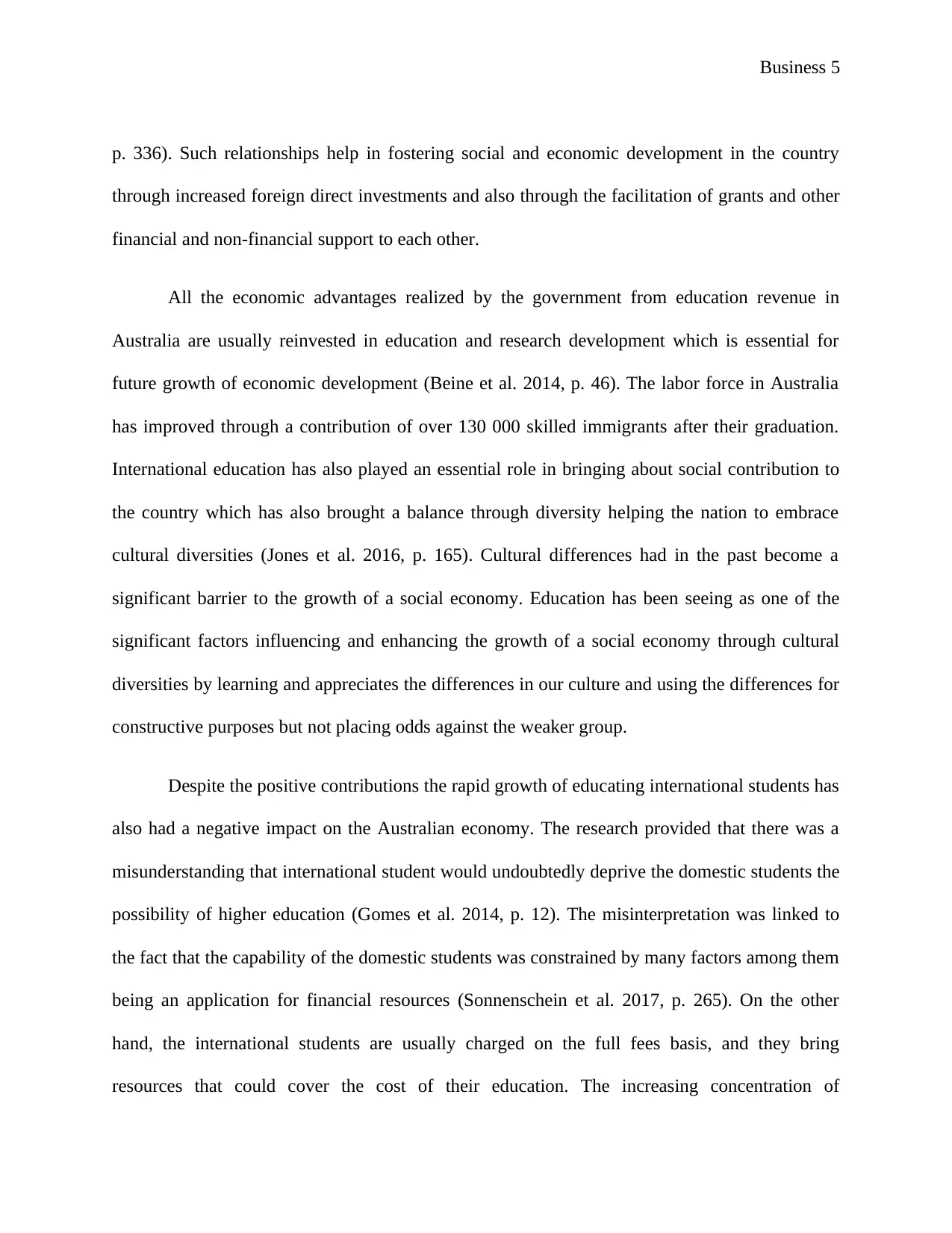
Business 5
p. 336). Such relationships help in fostering social and economic development in the country
through increased foreign direct investments and also through the facilitation of grants and other
financial and non-financial support to each other.
All the economic advantages realized by the government from education revenue in
Australia are usually reinvested in education and research development which is essential for
future growth of economic development (Beine et al. 2014, p. 46). The labor force in Australia
has improved through a contribution of over 130 000 skilled immigrants after their graduation.
International education has also played an essential role in bringing about social contribution to
the country which has also brought a balance through diversity helping the nation to embrace
cultural diversities (Jones et al. 2016, p. 165). Cultural differences had in the past become a
significant barrier to the growth of a social economy. Education has been seeing as one of the
significant factors influencing and enhancing the growth of a social economy through cultural
diversities by learning and appreciates the differences in our culture and using the differences for
constructive purposes but not placing odds against the weaker group.
Despite the positive contributions the rapid growth of educating international students has
also had a negative impact on the Australian economy. The research provided that there was a
misunderstanding that international student would undoubtedly deprive the domestic students the
possibility of higher education (Gomes et al. 2014, p. 12). The misinterpretation was linked to
the fact that the capability of the domestic students was constrained by many factors among them
being an application for financial resources (Sonnenschein et al. 2017, p. 265). On the other
hand, the international students are usually charged on the full fees basis, and they bring
resources that could cover the cost of their education. The increasing concentration of
p. 336). Such relationships help in fostering social and economic development in the country
through increased foreign direct investments and also through the facilitation of grants and other
financial and non-financial support to each other.
All the economic advantages realized by the government from education revenue in
Australia are usually reinvested in education and research development which is essential for
future growth of economic development (Beine et al. 2014, p. 46). The labor force in Australia
has improved through a contribution of over 130 000 skilled immigrants after their graduation.
International education has also played an essential role in bringing about social contribution to
the country which has also brought a balance through diversity helping the nation to embrace
cultural diversities (Jones et al. 2016, p. 165). Cultural differences had in the past become a
significant barrier to the growth of a social economy. Education has been seeing as one of the
significant factors influencing and enhancing the growth of a social economy through cultural
diversities by learning and appreciates the differences in our culture and using the differences for
constructive purposes but not placing odds against the weaker group.
Despite the positive contributions the rapid growth of educating international students has
also had a negative impact on the Australian economy. The research provided that there was a
misunderstanding that international student would undoubtedly deprive the domestic students the
possibility of higher education (Gomes et al. 2014, p. 12). The misinterpretation was linked to
the fact that the capability of the domestic students was constrained by many factors among them
being an application for financial resources (Sonnenschein et al. 2017, p. 265). On the other
hand, the international students are usually charged on the full fees basis, and they bring
resources that could cover the cost of their education. The increasing concentration of
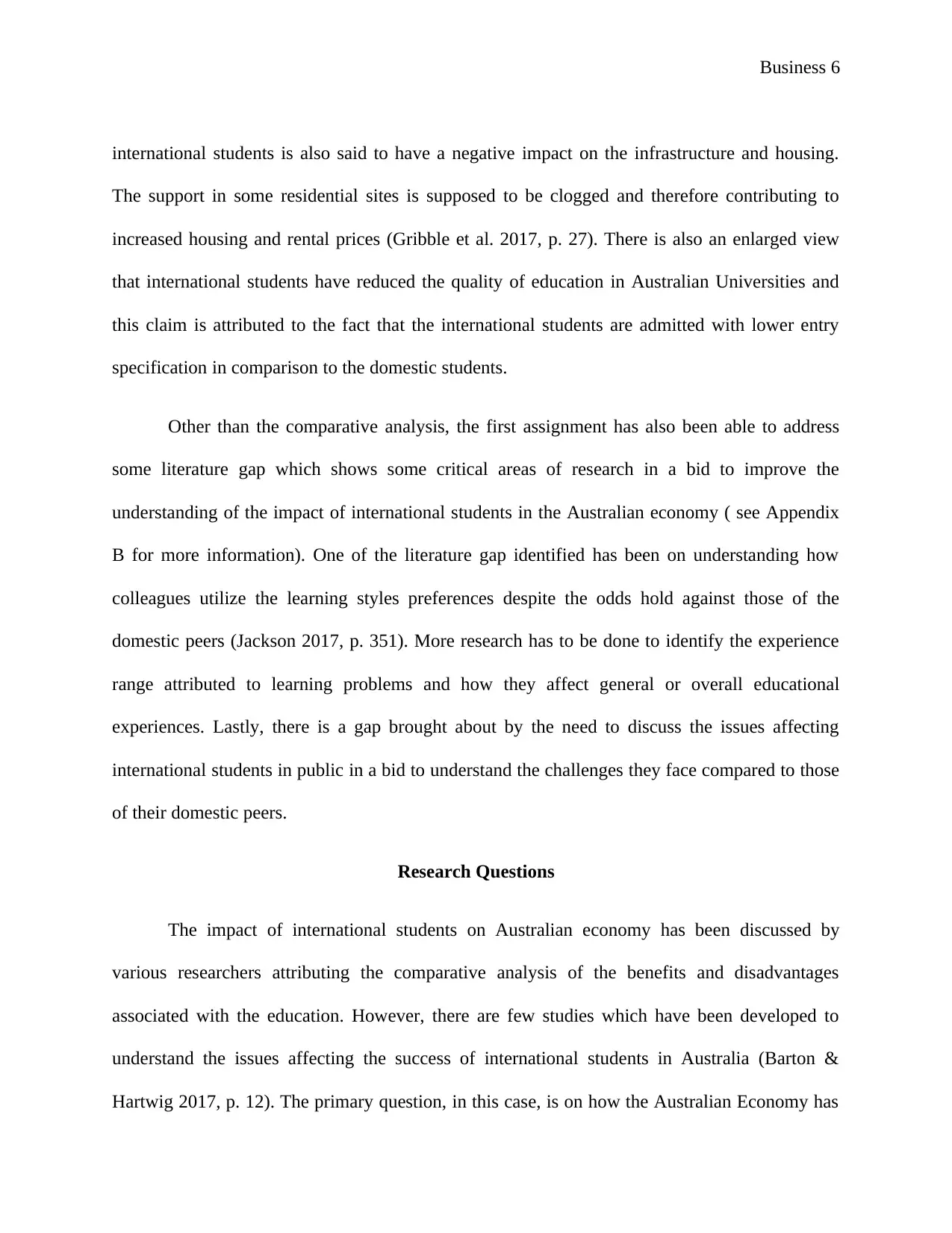
Business 6
international students is also said to have a negative impact on the infrastructure and housing.
The support in some residential sites is supposed to be clogged and therefore contributing to
increased housing and rental prices (Gribble et al. 2017, p. 27). There is also an enlarged view
that international students have reduced the quality of education in Australian Universities and
this claim is attributed to the fact that the international students are admitted with lower entry
specification in comparison to the domestic students.
Other than the comparative analysis, the first assignment has also been able to address
some literature gap which shows some critical areas of research in a bid to improve the
understanding of the impact of international students in the Australian economy ( see Appendix
B for more information). One of the literature gap identified has been on understanding how
colleagues utilize the learning styles preferences despite the odds hold against those of the
domestic peers (Jackson 2017, p. 351). More research has to be done to identify the experience
range attributed to learning problems and how they affect general or overall educational
experiences. Lastly, there is a gap brought about by the need to discuss the issues affecting
international students in public in a bid to understand the challenges they face compared to those
of their domestic peers.
Research Questions
The impact of international students on Australian economy has been discussed by
various researchers attributing the comparative analysis of the benefits and disadvantages
associated with the education. However, there are few studies which have been developed to
understand the issues affecting the success of international students in Australia (Barton &
Hartwig 2017, p. 12). The primary question, in this case, is on how the Australian Economy has
international students is also said to have a negative impact on the infrastructure and housing.
The support in some residential sites is supposed to be clogged and therefore contributing to
increased housing and rental prices (Gribble et al. 2017, p. 27). There is also an enlarged view
that international students have reduced the quality of education in Australian Universities and
this claim is attributed to the fact that the international students are admitted with lower entry
specification in comparison to the domestic students.
Other than the comparative analysis, the first assignment has also been able to address
some literature gap which shows some critical areas of research in a bid to improve the
understanding of the impact of international students in the Australian economy ( see Appendix
B for more information). One of the literature gap identified has been on understanding how
colleagues utilize the learning styles preferences despite the odds hold against those of the
domestic peers (Jackson 2017, p. 351). More research has to be done to identify the experience
range attributed to learning problems and how they affect general or overall educational
experiences. Lastly, there is a gap brought about by the need to discuss the issues affecting
international students in public in a bid to understand the challenges they face compared to those
of their domestic peers.
Research Questions
The impact of international students on Australian economy has been discussed by
various researchers attributing the comparative analysis of the benefits and disadvantages
associated with the education. However, there are few studies which have been developed to
understand the issues affecting the success of international students in Australia (Barton &
Hartwig 2017, p. 12). The primary question, in this case, is on how the Australian Economy has
⊘ This is a preview!⊘
Do you want full access?
Subscribe today to unlock all pages.

Trusted by 1+ million students worldwide
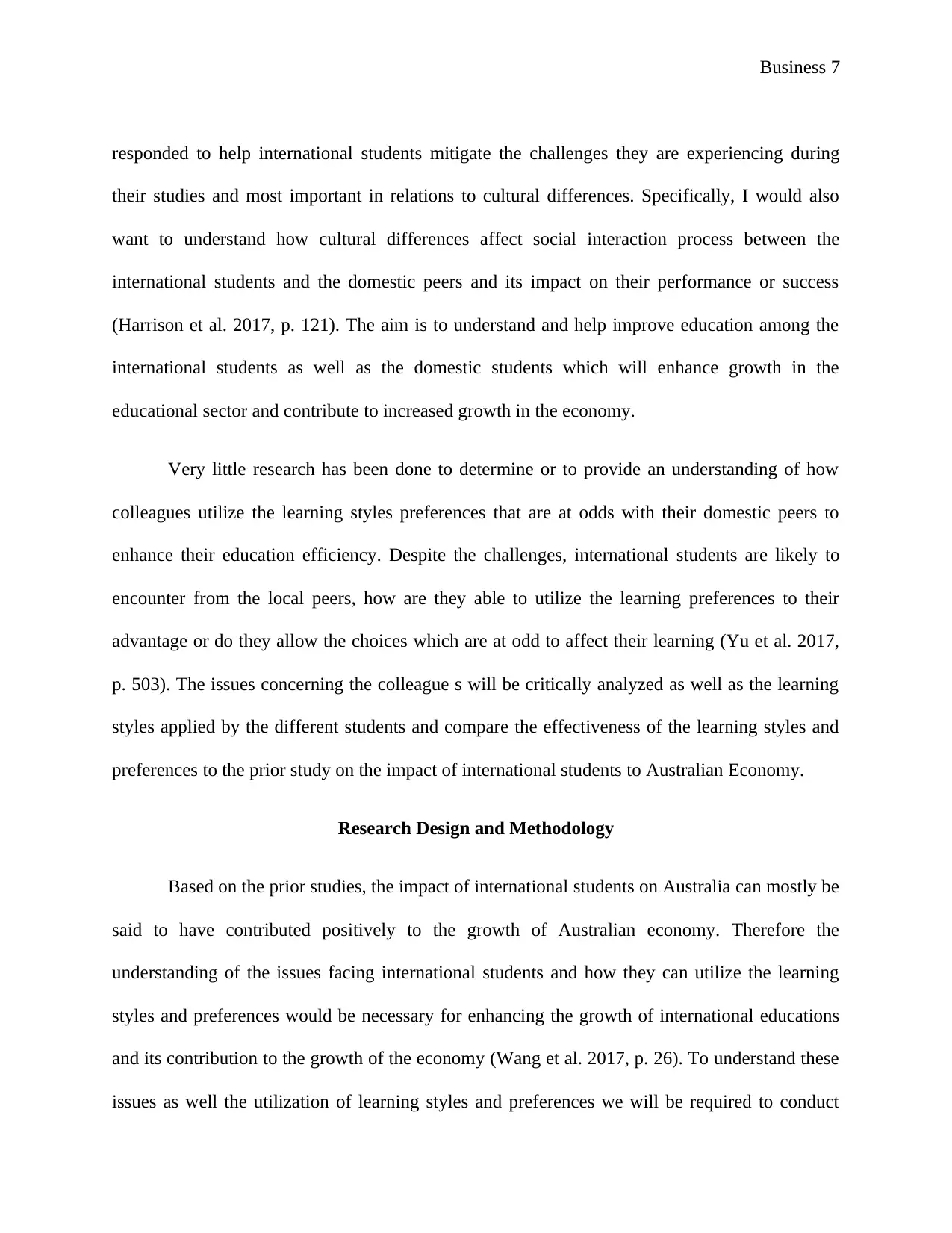
Business 7
responded to help international students mitigate the challenges they are experiencing during
their studies and most important in relations to cultural differences. Specifically, I would also
want to understand how cultural differences affect social interaction process between the
international students and the domestic peers and its impact on their performance or success
(Harrison et al. 2017, p. 121). The aim is to understand and help improve education among the
international students as well as the domestic students which will enhance growth in the
educational sector and contribute to increased growth in the economy.
Very little research has been done to determine or to provide an understanding of how
colleagues utilize the learning styles preferences that are at odds with their domestic peers to
enhance their education efficiency. Despite the challenges, international students are likely to
encounter from the local peers, how are they able to utilize the learning preferences to their
advantage or do they allow the choices which are at odd to affect their learning (Yu et al. 2017,
p. 503). The issues concerning the colleague s will be critically analyzed as well as the learning
styles applied by the different students and compare the effectiveness of the learning styles and
preferences to the prior study on the impact of international students to Australian Economy.
Research Design and Methodology
Based on the prior studies, the impact of international students on Australia can mostly be
said to have contributed positively to the growth of Australian economy. Therefore the
understanding of the issues facing international students and how they can utilize the learning
styles and preferences would be necessary for enhancing the growth of international educations
and its contribution to the growth of the economy (Wang et al. 2017, p. 26). To understand these
issues as well the utilization of learning styles and preferences we will be required to conduct
responded to help international students mitigate the challenges they are experiencing during
their studies and most important in relations to cultural differences. Specifically, I would also
want to understand how cultural differences affect social interaction process between the
international students and the domestic peers and its impact on their performance or success
(Harrison et al. 2017, p. 121). The aim is to understand and help improve education among the
international students as well as the domestic students which will enhance growth in the
educational sector and contribute to increased growth in the economy.
Very little research has been done to determine or to provide an understanding of how
colleagues utilize the learning styles preferences that are at odds with their domestic peers to
enhance their education efficiency. Despite the challenges, international students are likely to
encounter from the local peers, how are they able to utilize the learning preferences to their
advantage or do they allow the choices which are at odd to affect their learning (Yu et al. 2017,
p. 503). The issues concerning the colleague s will be critically analyzed as well as the learning
styles applied by the different students and compare the effectiveness of the learning styles and
preferences to the prior study on the impact of international students to Australian Economy.
Research Design and Methodology
Based on the prior studies, the impact of international students on Australia can mostly be
said to have contributed positively to the growth of Australian economy. Therefore the
understanding of the issues facing international students and how they can utilize the learning
styles and preferences would be necessary for enhancing the growth of international educations
and its contribution to the growth of the economy (Wang et al. 2017, p. 26). To understand these
issues as well the utilization of learning styles and preferences we will be required to conduct
Paraphrase This Document
Need a fresh take? Get an instant paraphrase of this document with our AI Paraphraser
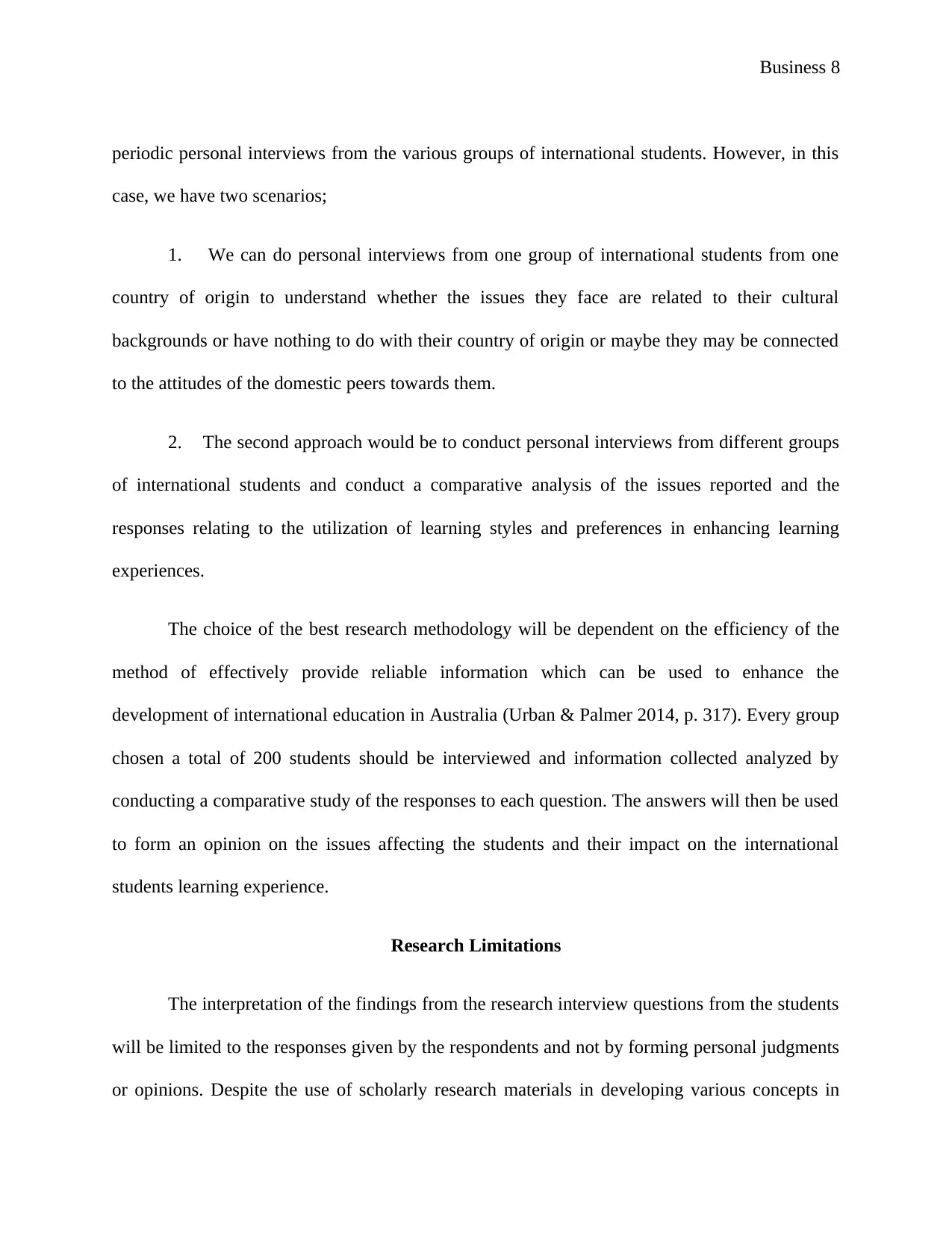
Business 8
periodic personal interviews from the various groups of international students. However, in this
case, we have two scenarios;
1. We can do personal interviews from one group of international students from one
country of origin to understand whether the issues they face are related to their cultural
backgrounds or have nothing to do with their country of origin or maybe they may be connected
to the attitudes of the domestic peers towards them.
2. The second approach would be to conduct personal interviews from different groups
of international students and conduct a comparative analysis of the issues reported and the
responses relating to the utilization of learning styles and preferences in enhancing learning
experiences.
The choice of the best research methodology will be dependent on the efficiency of the
method of effectively provide reliable information which can be used to enhance the
development of international education in Australia (Urban & Palmer 2014, p. 317). Every group
chosen a total of 200 students should be interviewed and information collected analyzed by
conducting a comparative study of the responses to each question. The answers will then be used
to form an opinion on the issues affecting the students and their impact on the international
students learning experience.
Research Limitations
The interpretation of the findings from the research interview questions from the students
will be limited to the responses given by the respondents and not by forming personal judgments
or opinions. Despite the use of scholarly research materials in developing various concepts in
periodic personal interviews from the various groups of international students. However, in this
case, we have two scenarios;
1. We can do personal interviews from one group of international students from one
country of origin to understand whether the issues they face are related to their cultural
backgrounds or have nothing to do with their country of origin or maybe they may be connected
to the attitudes of the domestic peers towards them.
2. The second approach would be to conduct personal interviews from different groups
of international students and conduct a comparative analysis of the issues reported and the
responses relating to the utilization of learning styles and preferences in enhancing learning
experiences.
The choice of the best research methodology will be dependent on the efficiency of the
method of effectively provide reliable information which can be used to enhance the
development of international education in Australia (Urban & Palmer 2014, p. 317). Every group
chosen a total of 200 students should be interviewed and information collected analyzed by
conducting a comparative study of the responses to each question. The answers will then be used
to form an opinion on the issues affecting the students and their impact on the international
students learning experience.
Research Limitations
The interpretation of the findings from the research interview questions from the students
will be limited to the responses given by the respondents and not by forming personal judgments
or opinions. Despite the use of scholarly research materials in developing various concepts in
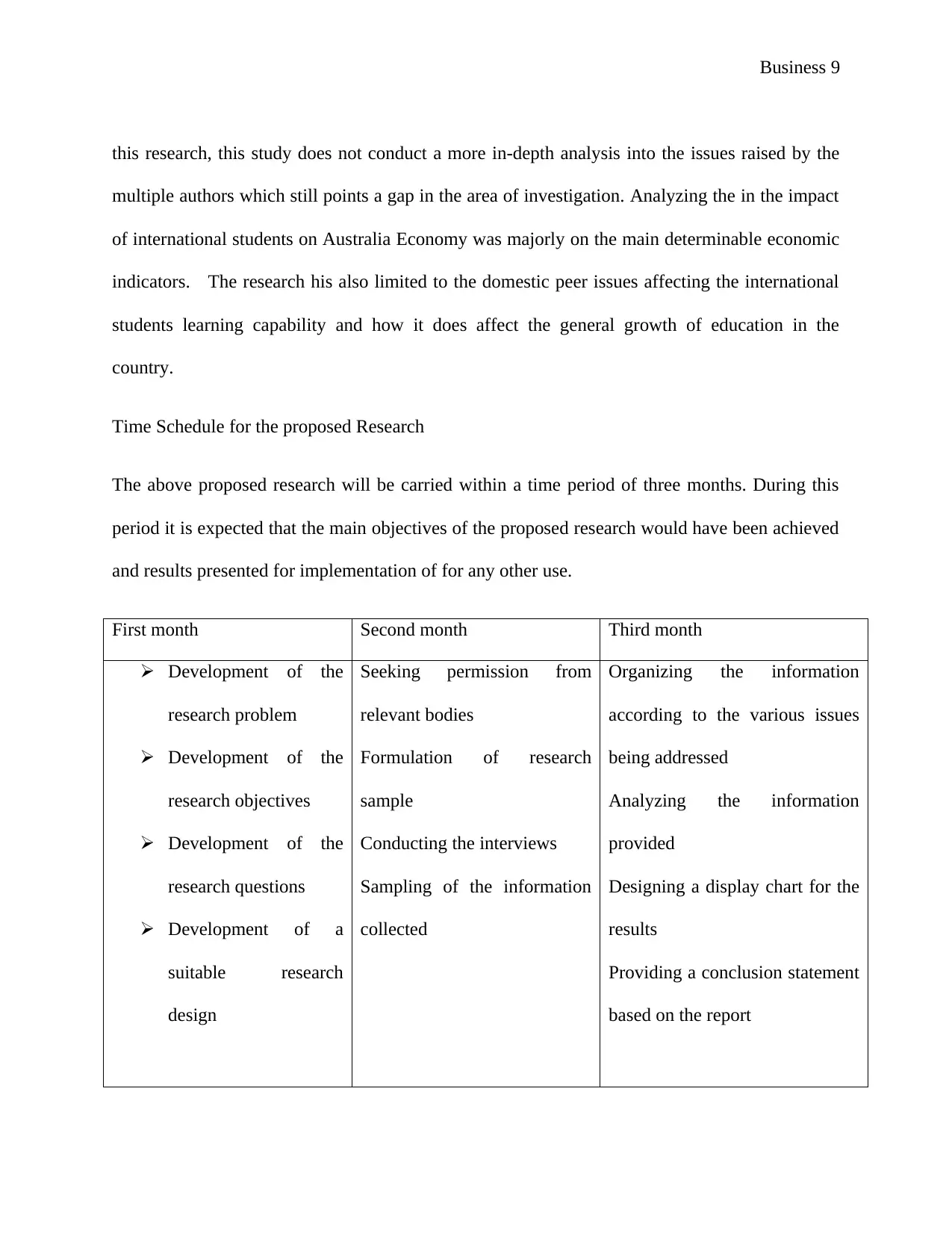
Business 9
this research, this study does not conduct a more in-depth analysis into the issues raised by the
multiple authors which still points a gap in the area of investigation. Analyzing the in the impact
of international students on Australia Economy was majorly on the main determinable economic
indicators. The research his also limited to the domestic peer issues affecting the international
students learning capability and how it does affect the general growth of education in the
country.
Time Schedule for the proposed Research
The above proposed research will be carried within a time period of three months. During this
period it is expected that the main objectives of the proposed research would have been achieved
and results presented for implementation of for any other use.
First month Second month Third month
Development of the
research problem
Development of the
research objectives
Development of the
research questions
Development of a
suitable research
design
Seeking permission from
relevant bodies
Formulation of research
sample
Conducting the interviews
Sampling of the information
collected
Organizing the information
according to the various issues
being addressed
Analyzing the information
provided
Designing a display chart for the
results
Providing a conclusion statement
based on the report
this research, this study does not conduct a more in-depth analysis into the issues raised by the
multiple authors which still points a gap in the area of investigation. Analyzing the in the impact
of international students on Australia Economy was majorly on the main determinable economic
indicators. The research his also limited to the domestic peer issues affecting the international
students learning capability and how it does affect the general growth of education in the
country.
Time Schedule for the proposed Research
The above proposed research will be carried within a time period of three months. During this
period it is expected that the main objectives of the proposed research would have been achieved
and results presented for implementation of for any other use.
First month Second month Third month
Development of the
research problem
Development of the
research objectives
Development of the
research questions
Development of a
suitable research
design
Seeking permission from
relevant bodies
Formulation of research
sample
Conducting the interviews
Sampling of the information
collected
Organizing the information
according to the various issues
being addressed
Analyzing the information
provided
Designing a display chart for the
results
Providing a conclusion statement
based on the report
⊘ This is a preview!⊘
Do you want full access?
Subscribe today to unlock all pages.

Trusted by 1+ million students worldwide
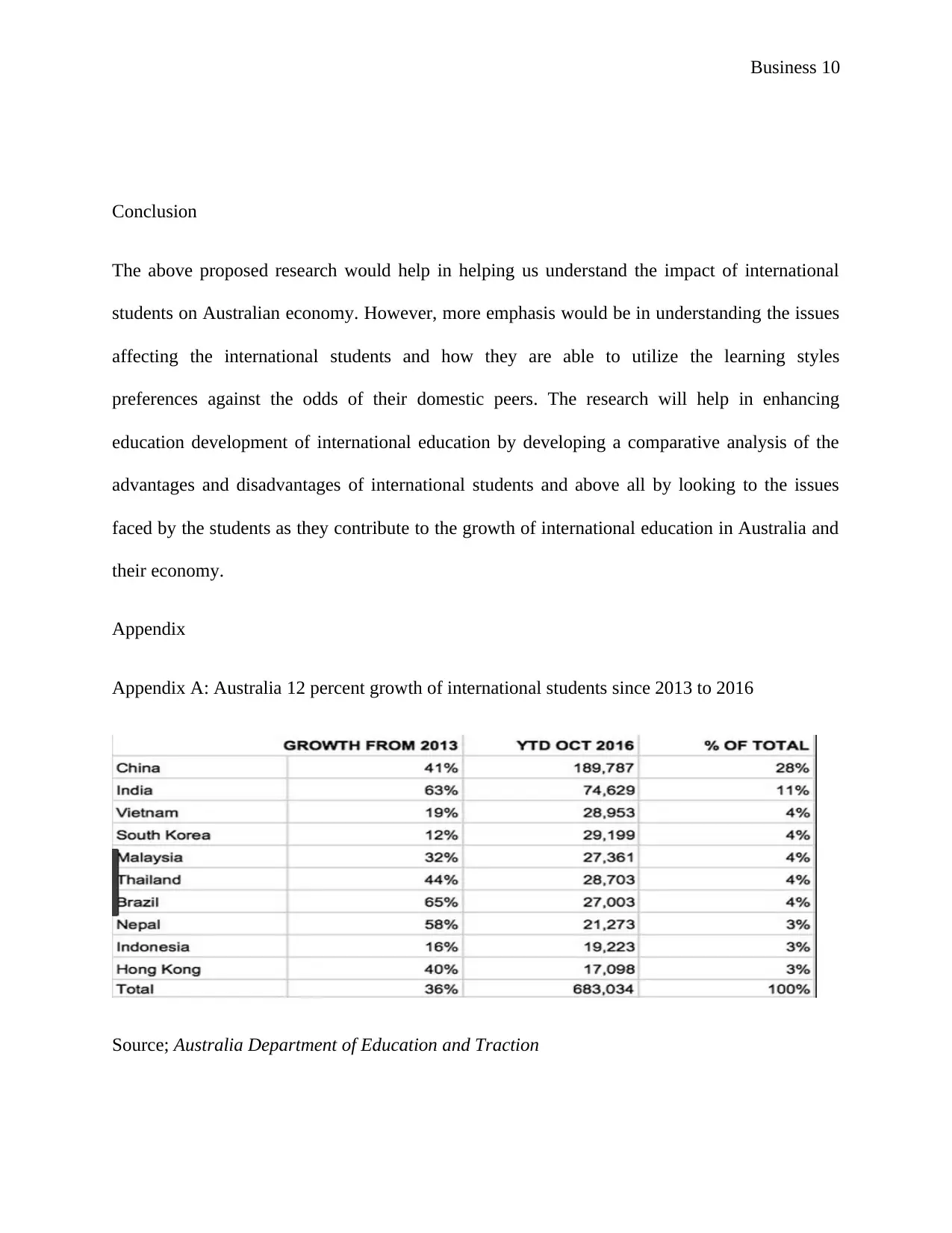
Business 10
Conclusion
The above proposed research would help in helping us understand the impact of international
students on Australian economy. However, more emphasis would be in understanding the issues
affecting the international students and how they are able to utilize the learning styles
preferences against the odds of their domestic peers. The research will help in enhancing
education development of international education by developing a comparative analysis of the
advantages and disadvantages of international students and above all by looking to the issues
faced by the students as they contribute to the growth of international education in Australia and
their economy.
Appendix
Appendix A: Australia 12 percent growth of international students since 2013 to 2016
Source; Australia Department of Education and Traction
Conclusion
The above proposed research would help in helping us understand the impact of international
students on Australian economy. However, more emphasis would be in understanding the issues
affecting the international students and how they are able to utilize the learning styles
preferences against the odds of their domestic peers. The research will help in enhancing
education development of international education by developing a comparative analysis of the
advantages and disadvantages of international students and above all by looking to the issues
faced by the students as they contribute to the growth of international education in Australia and
their economy.
Appendix
Appendix A: Australia 12 percent growth of international students since 2013 to 2016
Source; Australia Department of Education and Traction
Paraphrase This Document
Need a fresh take? Get an instant paraphrase of this document with our AI Paraphraser
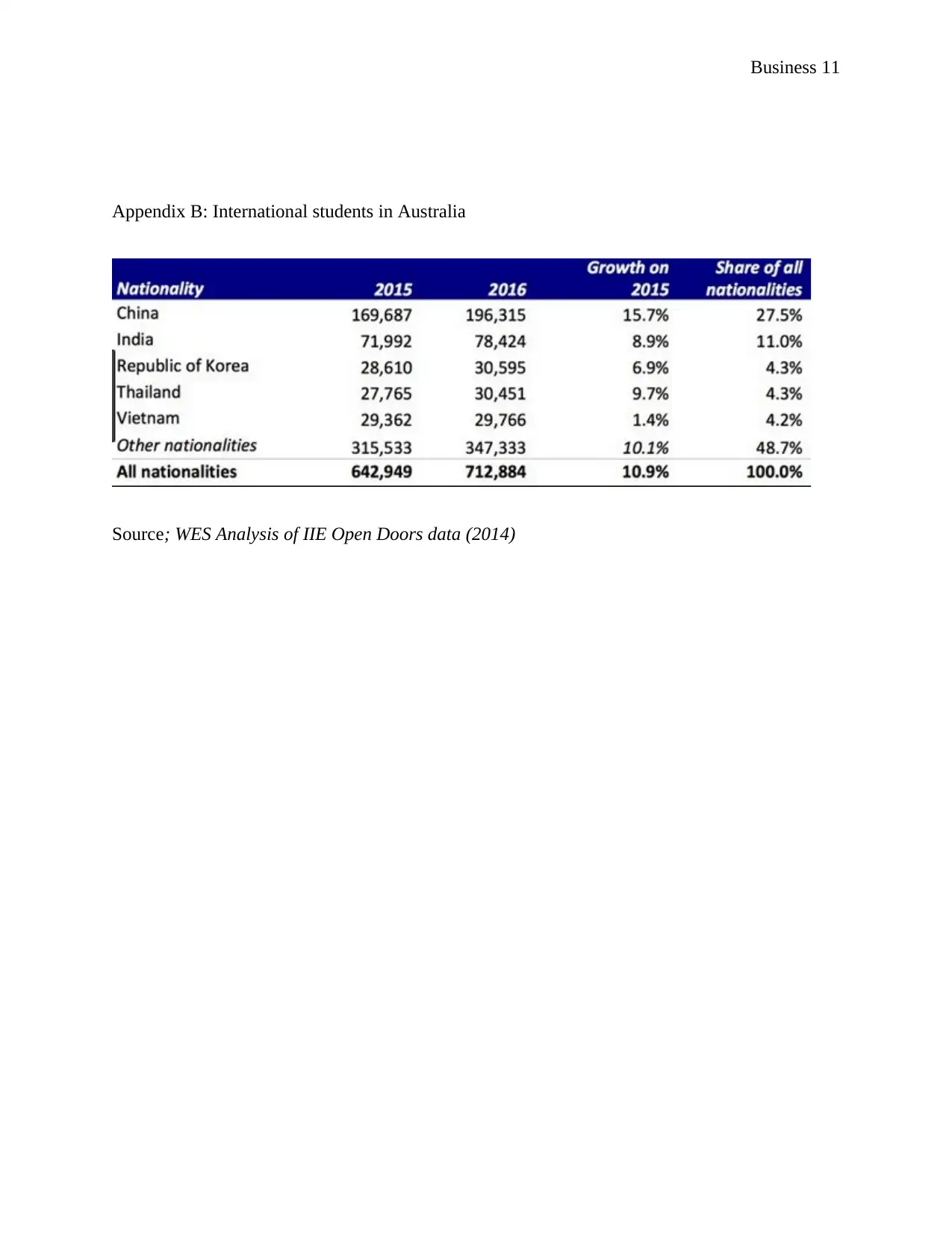
Business 11
Appendix B: International students in Australia
Source; WES Analysis of IIE Open Doors data (2014)
Appendix B: International students in Australia
Source; WES Analysis of IIE Open Doors data (2014)
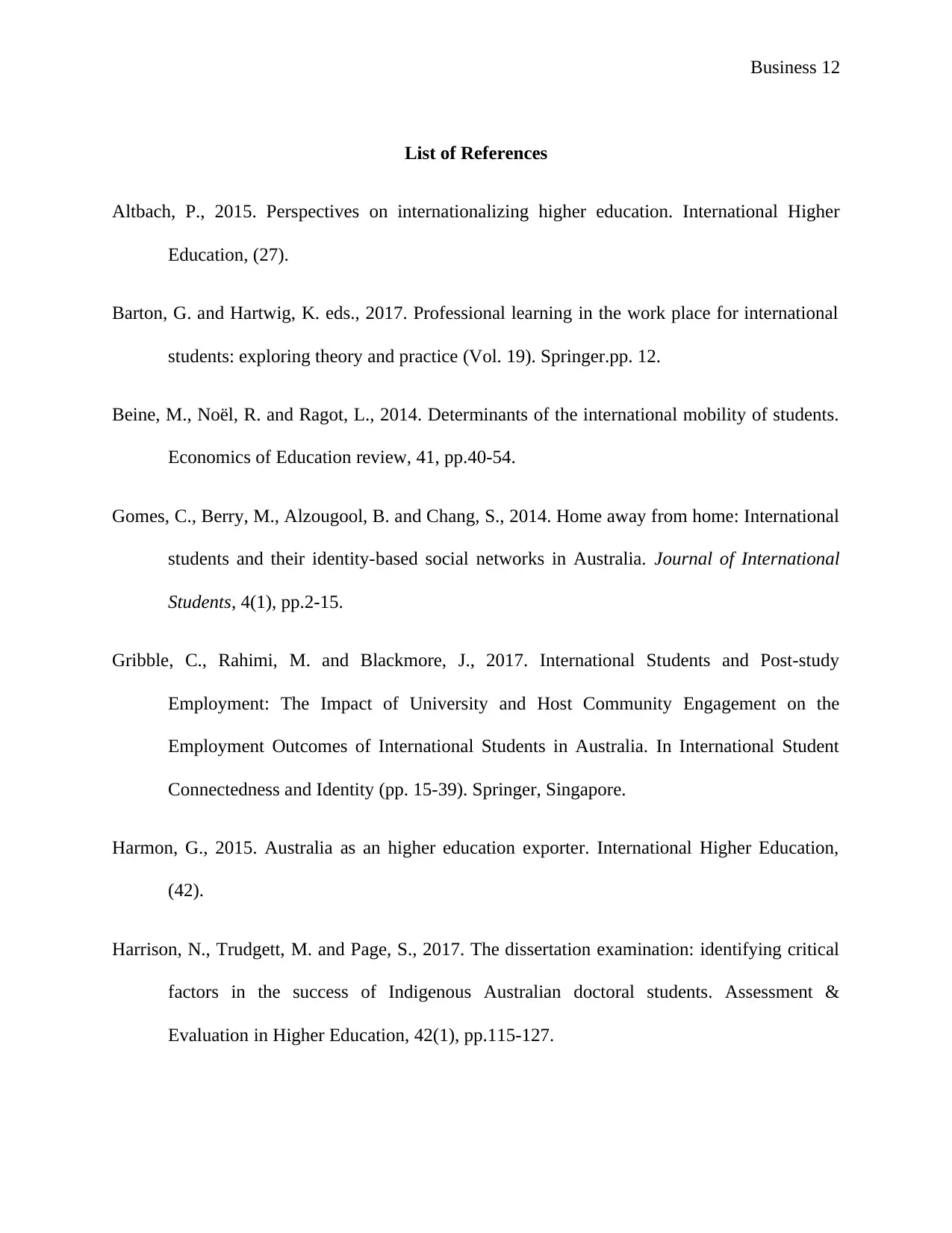
Business 12
List of References
Altbach, P., 2015. Perspectives on internationalizing higher education. International Higher
Education, (27).
Barton, G. and Hartwig, K. eds., 2017. Professional learning in the work place for international
students: exploring theory and practice (Vol. 19). Springer.pp. 12.
Beine, M., Noël, R. and Ragot, L., 2014. Determinants of the international mobility of students.
Economics of Education review, 41, pp.40-54.
Gomes, C., Berry, M., Alzougool, B. and Chang, S., 2014. Home away from home: International
students and their identity-based social networks in Australia. Journal of International
Students, 4(1), pp.2-15.
Gribble, C., Rahimi, M. and Blackmore, J., 2017. International Students and Post-study
Employment: The Impact of University and Host Community Engagement on the
Employment Outcomes of International Students in Australia. In International Student
Connectedness and Identity (pp. 15-39). Springer, Singapore.
Harmon, G., 2015. Australia as an higher education exporter. International Higher Education,
(42).
Harrison, N., Trudgett, M. and Page, S., 2017. The dissertation examination: identifying critical
factors in the success of Indigenous Australian doctoral students. Assessment &
Evaluation in Higher Education, 42(1), pp.115-127.
List of References
Altbach, P., 2015. Perspectives on internationalizing higher education. International Higher
Education, (27).
Barton, G. and Hartwig, K. eds., 2017. Professional learning in the work place for international
students: exploring theory and practice (Vol. 19). Springer.pp. 12.
Beine, M., Noël, R. and Ragot, L., 2014. Determinants of the international mobility of students.
Economics of Education review, 41, pp.40-54.
Gomes, C., Berry, M., Alzougool, B. and Chang, S., 2014. Home away from home: International
students and their identity-based social networks in Australia. Journal of International
Students, 4(1), pp.2-15.
Gribble, C., Rahimi, M. and Blackmore, J., 2017. International Students and Post-study
Employment: The Impact of University and Host Community Engagement on the
Employment Outcomes of International Students in Australia. In International Student
Connectedness and Identity (pp. 15-39). Springer, Singapore.
Harmon, G., 2015. Australia as an higher education exporter. International Higher Education,
(42).
Harrison, N., Trudgett, M. and Page, S., 2017. The dissertation examination: identifying critical
factors in the success of Indigenous Australian doctoral students. Assessment &
Evaluation in Higher Education, 42(1), pp.115-127.
⊘ This is a preview!⊘
Do you want full access?
Subscribe today to unlock all pages.

Trusted by 1+ million students worldwide
1 out of 14
Related Documents
Your All-in-One AI-Powered Toolkit for Academic Success.
+13062052269
info@desklib.com
Available 24*7 on WhatsApp / Email
![[object Object]](/_next/static/media/star-bottom.7253800d.svg)
Unlock your academic potential
Copyright © 2020–2025 A2Z Services. All Rights Reserved. Developed and managed by ZUCOL.




